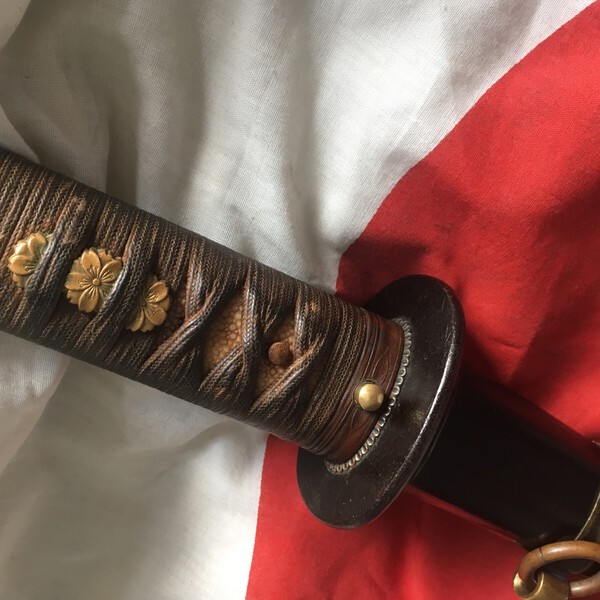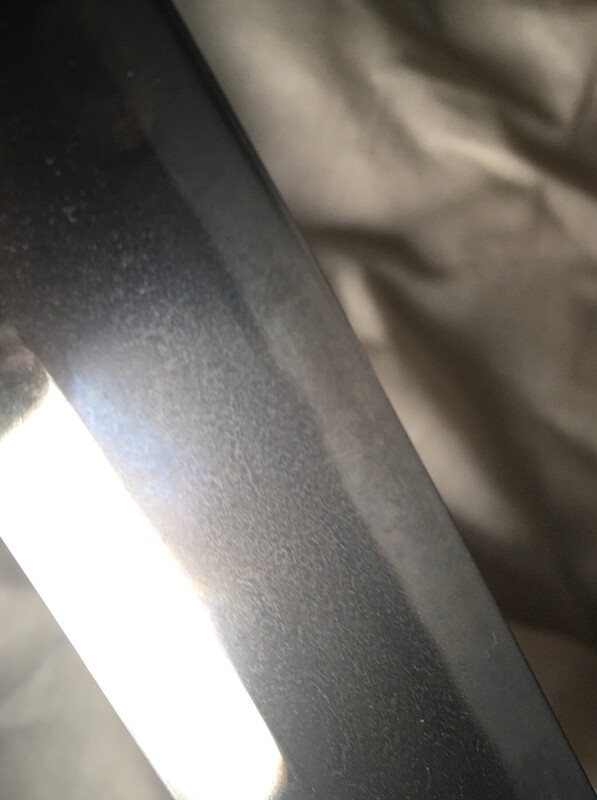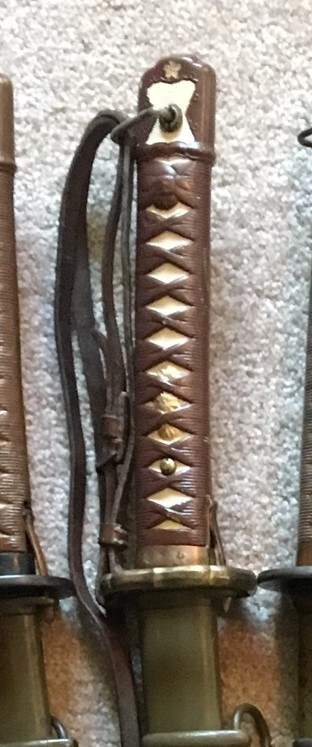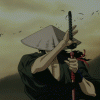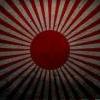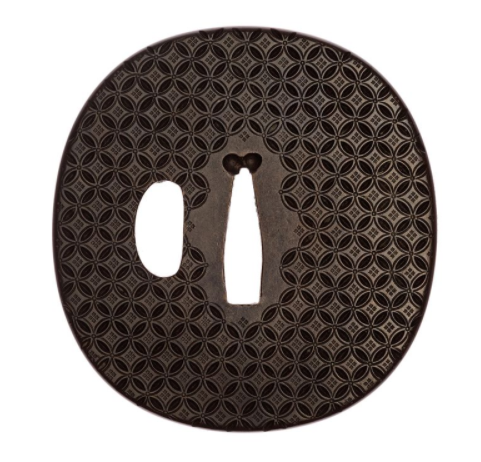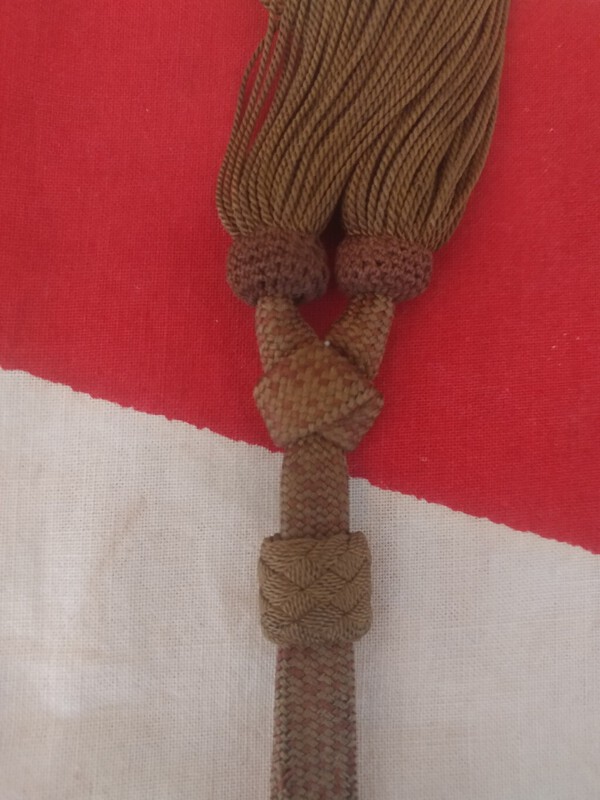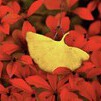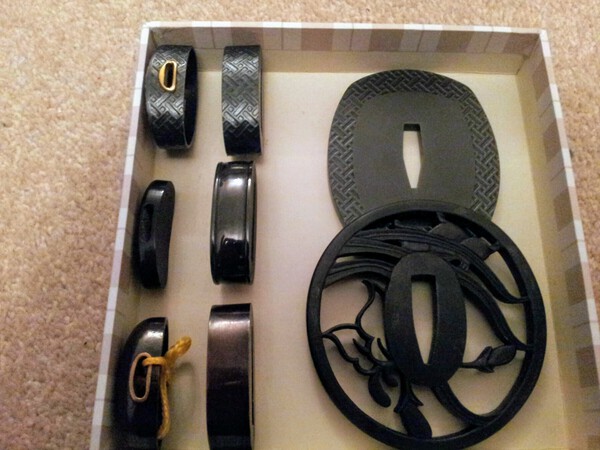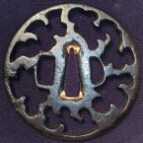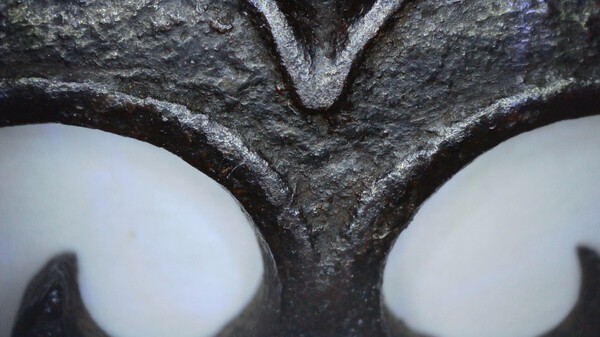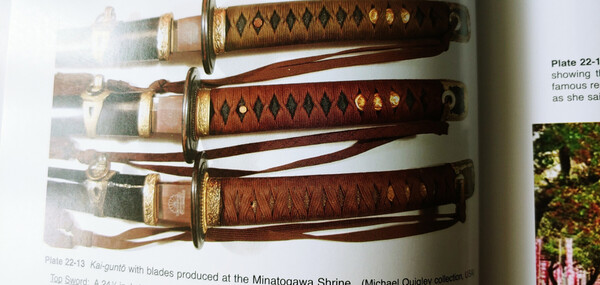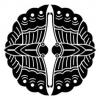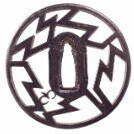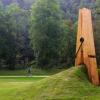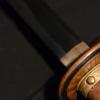Leaderboard
Popular Content
Showing content with the highest reputation on 12/08/2021 in all areas
-
4 points
-
My latest sword is a Type 3 Gendaito blade signed I believe by AKIHISA. The fiitings are in good order with a mon attached. Having checked the blade there are no evidence of any markings only what’s on the tang. The saya is flat black lacquer on a wood sayer with a matching to fittings bottom chap. Many thanks Gareth3 points
-
3 points
-
Nice pick up Paul ! i noticed that the sarute barrel nut (which holds the handle to the blade) is actually a replacement. Whether it was an Arsenal re-work, or field repair, or even post war replacement by someone wanting to see if there was a signature is almost impossible to tell. The original barrel nuts were also made of copper. Would you be able to post a photo of the drag please? (an overhead shot, not on the angle as your other photos) It looks as if the brass plug is semi circular in appearance. Stephen, Dawsons book only lists #6561 as the highest 'observed' serial number, no photographic evidence unfortunately. The source is unknown, however, he mentions {various sources but primarily Donald Barnes}, who also assisted Fuller & Gregory with their list. His list also mentions the cross blade stamping of 501 (which is generally between the end of the bohi and the habiki) for this sword so i would be inclined to believe it is a real observation. The earliest Aluminium handled sword i have observed is #6756, so to answer your question directly..... Bruce is on the mark, as the cut off is somewhere inbetween!3 points
-
Hi Robert these are relatively common patterned guards [until you want to find one!] This is an unusually good one with a fukurin [rim cover] https://www.jauce.com/auction/q1024331165 in soft metal, a lot are also signed and have a kao [seal]. Most examples are in Iron. There were three or four that have sold in the last few weeks that I know of [I bought one for 2,000 yen - rusty] I noticed the comments in the other thread on how hard it would be to do that repeated pattern so precisely by hand - multiply that by ten when it is done on iron instead of a soft metal like shakudo or shibuichi!3 points
-
2 points
-
2 points
-
2 points
-
Hello Bruce, Thank you,.....altering it now....Knot is a replacement I have had for years but very good quality....nearly all the nco knots I come across are really fragile so I just use this one for effect. Regards, Paul..2 points
-
2 points
-
i wrote them, it is casting s**t , not silver, not edo, NO ANSWER Thomas Del Mar Ltd, London, United Kingdom= BIG s**t2 points
-
2 points
-
And by 7900 these transition models were done and the 'classical' Pattern 2 aluminium hilts with brass tsuba were in production. Might be a bit earlier too, but that's what I recall without double checking. I actually got rid of my PC so it's a bit of a pain to find my old notes.2 points
-
Just for clarity, the process for making contemporary coins (machine-struck coinage) involves the use of blanks of uniform thickness and dyes to emboss the design. There is a lot of fine detail, but the process is limited. While a set of dyes can produce thousands of coins, the dyes are expensive to produce and the depth of the design is very shallow. Dye casting is a possibility, but I'm not sure you could achieve this level of detail, and to have any chance of doing so you'd likely need the dyes to be hand carved by Ford Hallam. This could be quite the challenge for even someone of his level of mastery, as the design would need to be carved as a negative. Plaster casting is more labour intensive than investment casting, as the plaster mould is single use, but it isn't a prohibitively expensive process. The main difference to investment casting is that you remove a couple of layers of abstraction from the original piece (retaining more detail). With investment casting you: Select the piece you'll be reproducing, known as the master pattern (in this case, likely an original tsuba). Create a mould (known as the master dye) of the master pattern. Produce a wax pattern. I have seen Chinese fittings (for Jian) being made without the use of a master pattern, with the single use wax pattern being hand carved. Apply investment materials, often a ceramic slurry, which is then cured. Dewax, melt and remove the internal wax to leave a clean ceramic shell. Burnout the mould to remove any moisture and residual wax. Fill the mould (with molten metal). Remove the shell to release the casting. Finish the workpiece. With plaster casting you: Select the piece you'll be reproducing, known as the master pattern (in this case, likely an original tsuba). Create a plaster mould. Bake the mould to remove any excess water. Fill the mould (with molten metal). Break the mould to release the casting. Finish the workpiece. As you can intuit from the process difference, this makes quite a lot of difference to the detail retained in the finished piece and the labour costs involved. Fred Lohman in the US has been making quite nice cast fittings for martial arts use for a long time. I would presume that he's plaster casting too, but I don't know for sure. Fred Lohman's pricing is a fair bit higher than the prices mentioned in the OP if I recall correctly. I would presume that the difference is mostly due to the difference in labour costs in China vs the US. I think at the prices mentioned in the OP that these are good value given the labour involved, assuming of course that you know what you're buying and they're not misrepresented by the seller.2 points
-
Jean L. What frightens me is a huge number of fakes that are listed at the high end of prices not the low. You might laugh at some of these: https://www.jauce.com/auction/c738641596 https://www.ebay.com.au/itm/254393179943 - https://www.ebay.com.au/itm/265400937434 - https://www.ebay.com.au/itm/313782033171 [WTF] https://www.ebay.com.au/itm/324320515489 - https://www.ebay.com.au/itm/313782032622 - https://www.ebay.com.au/itm/265418601464 The two cast replicas below are ridiculously priced for their scrap value - I have two myself and have images of nearly a dozen just like them - all but one are fakes. And these are not as good as the new ones coming out. Mark: I swear some fakes are punched out in the same manner as coinage - industrial counterfeits! You might like to check the prices on these modern fakes.2 points
-
2 points
-
2 points
-
No malice here David, or bubbles burst. It is only disturbing how much traction fakes or non Japanese swords have been receiving of late. Thought it would be nice to divert some thinking towards something more exciting to long time collectors.2 points
-
1 point
-
All, I asked Brian to upload an article titled “Swords of the Tea Masters” in pdf format. It was in a periodical called “Chanoyu Quarterly” which is now out of print. While not in-depth Nihonto info and written more for a tea ceremony practitioner audience, some might still enjoy the read. You will find it in the ‘download’ section. Hope you will find it interesting. Mark S.1 point
-
does our current history go? searching Emura wont go back past 2006 in custom time. way back machine doesn't have any before 2008 so i guess its lost to my memory ....which is like Teflon1 point
-
1 point
-
A few years ago I spent quite a long time studying a traditional textile pattern tsuba made of copper (in hand), and I would have been willing to bet money that the pattern was created by etching. As it was copper, my guess would have been ferric chloride, but I haven't been able to find any info on if this was known to and used by the Japanese of old. To satiate my curiosity, I later had a goldsmith use this technique to quite deeply etch copper plate to see how it would turn out. I gave away the item to a friend, but I think I still have a photo. Edit to add photos. The commissioned test piece mentioned above is the tsuba and F/K at the top of the first image. More detail is visible in the second image. Edit 2, everything shown in these images is modern. The other fuchi/ kashira were made by Patrick Hastings and the other tsuba is by Jesus Hernandez. They've all now been mounted on shinken/ iaito for martial arts use.1 point
-
Investment casting of Chinese sword fittings (with a carved wax pattern) is shown here at 9:40 if you're curious about the process. https://youtu.be/bajGAnLqy-E1 point
-
1 point
-
1 point
-
Chris I have looked through more than sixteen museum sites and every book I own - no match. I have seen a few Chinese fakes that have melded two tsuba designs into one [usually on opposite sides of the guard] so it is possible it is a compounded design, stick some fish tails on a dragon and you have something 'unique'. The golden Goto you showed me is the closest I have seen - but it could still be out there somewhere? I did note there are far less dragons looking up than there are ones looking down?1 point
-
1 point
-
1 point
-
Robert, It is only quoting the auction notes that often get scrambled by Google translate - and which are never to be trusted. Eiju seiryuken is a much more accurate translation, though the kao is often different. I have a rusty version on its way from Japan with half the mei obliterated. Why would you do that? More examples here: https://www.worthpoint.com/worthopedia/tsuba-snow-flower-seiryuken-eijyu-291169020 https://www.worthpoint.com/worthopedia/antique-Japanese-wakizashi-katana-1890403625 https://www.worthpoint.com/worthopedia/Japanese-iron-tsuba-eiju-takase-436170695 https://www.worthpoint.com/worthopedia/3683-edo-samurai-sword-elaborate-138649618 https://www.worthpoint.com/worthopedia/5053-jp-samurai-sword-shippo-pattern-wakizashi https://www.worthpoint.com/worthopedia/antique-sword-signed-eijyu-tsuba-katana-menuki Triple set here - https://www.worthpoint.com/worthopedia/3-signed-antique-Japanese-sword-tsuba-fuchi-kashira You do get the idea they are reasonably common!1 point
-
1 point
-
Thank you all, Christian, my Hoan tsuba now feels angry, and offended and now stares at me. Just look at that frown. I attach a close-up for my other similar tsuba in shape, and also an example of a Nishigaki tsuba and a close-up of one of the iron buckets. This makes me a bit curious about how the iron looks like from different schools and how can one tell the difference? Anyone? Christian, don't think the price should be a guide point to what is real or not, but I see your point. As the text referred to later Hoan, I thought around the 1800 ish time period. Would that be in the ballpark in your experience? The iron looks older to me. Best Björn1 point
-
1 point
-
1 point
-
I was going to joke that the owner must have had the crap scared out of him and his intense grip bent the tsuka! Maybe I wasn't so far off! @Shamsy and @Stegel can say with some assurance, but it's in the mid-6,000s.1 point
-
They look very decorative, Robert. No.1 is my favorite! Late Edo might be a good guess. The material used for a Jingasa in perfect condition is difficult to judge in many cases. Some will have a little damage on the edge which will allow you to see the inner construction and check that it is not a fiberglass fake. Many will just shout genuine at you, but you'll never be sure what is underneath.. Use of a magnet as Jean suggests may tell you why the heavier ones are heavy, but at first glance none of those look like typical iron jingasa. (Except possibly the first one) PS Tombo is the correct generic term for a dragonfly, but within the Bushi world they were/are only referred to as 'Katchimushi'. (Tombo sounds too innocent, like a child's word.)1 point
-
1 point
-
Ken +Katabami (swords + wood sorrel). The wood sorrel is good luck because it grows back no matter how much/often you cut it down. The swords are just a design motif that separates the leaves of the wood sorrel, but obviously swords are important in Japanese history/culture and would be considered an appropriate design for a family crest. This is a common family crest, and a bit difficult to pinpoint who might have used it since so many families adopted it.1 point
-
Thank you for posting that very interesting book Dirk, I'll need to add that one to my long book list. Here is a history bit from the Sano Museum book that I took a pic for your other thread. I skipped one paragraph so I could fit in these that I have now as it takes so much time for me to type the kanji and translate it so I chose these parts. I'll add the original text as I most likely might have made an error or two in the process. Gassan was a swordsmith of Mōgusa group. Edo period sources [古刀銘盡大全] and [校正古刀銘鑑] state that he was son of Kiōmaru and moved to Dewa. It is said that the first generation was around Genryaku (1184) and Kenkyū (1190) and continued for generations. Looking at dated work of the school, there is work by Gunshō dated to (1367) [My other source has this sword as 貞治二 1363] and Gunshō dated to (1385) [This is listed as 元中三 1386 in Juyo 21], in the Muromachi period Chikanori works from Bunki & Eishō, Masanobu works from Eishō, Toshiyoshi works from Daiei & Tenbun can be found. From Kamakura period until the Early Muromachi period the school signed Gassan saku or Gassan. From the middle of Muromachi period many smiths put their personal names under Gassan. Main smiths include Chikanori, Masanobu, Yoshihisa, Toshiyoshi, Muneyoshi and Sadamitsu.1 point
-
1 point
-
Hello and thank you for the comments, Nice to share information and hopefully prevent someone being “tucked up “ especially with the increased value . Some interesting points about the first model include for instance the hanging rings are 3.5 mm compared to the later 4.5 mm which may be a good indication the sword never revisited the arsenal or workshop for update or repair....Also the tsuka has a pronounced “ kick” to it reminiscent of ancient tachi , a feature that does not seem to appear on first models.. Regards, Paul..1 point
-
1 point
-
Hi treasure hunters, Thanks again to everybody who joined, I have uploaded several pictures on facebook as here it would overrun the file size limit. https://fb.me/e/2ex17pWCK Overall I was positively surprised how open all the dealers were regarding me taking pictures of the items. I also made one new friend it seems, the guy who had the blades, as he was very kind explaining what he knew. Also shared his lunch with me even though I tried to insist not to. Looking forward to our next hunt together! Cheers Paul 20211205_002953744_iOS.heic1 point
-
it is very rare but i have twice come across swords where the sarute' barrel nut goes through a second hole in at the base of the tang, doubt it is the case here but just mentioning1 point
-
Hi Alden, You will find Care and Cleaning here: https://nbthk-ab2.org/sword-characteristics/ which will tell you a lot about handling your sword. I wouldn't use Never Dull; it alters the surface appearance and you want to keep everything original at this point. Alcohol should remove the cosmoline and is the easiest to find. Any light machine oil will do fine for your blade; sewing machine oil for instance. Stephen's towel on a counter top method for removing the handle should work fine. Have an inch or 2 of the towel hanging over the edge so you don't damage the counter and lay the side of the sword without the spring clip on the towel. Draw the sword back and slide it forward, increasing force as needed until the blade starts to walk out of the handle. Other than removing the cosmoline, don't try to fix anything; well meaning amateurs often do unwitting damage. If your bamboo peg is damaged or brittle, replace it with a whittled chopstick. This pin is important as it locks the blade in the handle and prevents it from falling loose. Welcome to the club. Grey1 point
-
Aiden, Good buy for 400 US in my opinion but I do tend to collect some orphans. To remove peg (mekugi) you need something cylindrical and flat on the end....slightly smaller diameter than the mekugi peg thats in there. Try a large nail and cut or grind the point off,, so its flat and then then lightly sand so there are no rough edges. Then use it GENTLY to 'punch' the peg out. From your pics, it appears that the biggest end of the peg is on the same side as the chuso button (release button). If that is correct, then punch (softly/gently) the peg out from the OPPOSITE side. That is, you would be pushing the larger end of the peg out first. Only one peg is normal for yours. Yep, looks like cosmoline on the blade and everyone has a favourite removal potion but for my money, I would recommend a US product called NEVR-DULL it is impregnated wadding and while remove the old grease and put the blade in a much better position. Will take a lot of rubbing! Wont hurt the blade or impact on any hamon that may be lurking underneath. make sure you wipe it all off when finished each time and lightly oil. Dont clean any rust etc from the the tang (under the handle) maybe post a couple of pics and seek further advice on this point. Rob1 point
-
Hi Curran, First off good.to hear from you! As I replied to Jay and put computer down, i thought something goto has to be waki goto but i fell asleep instead of looking it up. i didn't realize they actually papered to waki goto. I am used to hearing waki goto and then the branch but that is probably because anytime i looked up wakigoto it was in association with a particular name (usually a gimei lol). Thanks for the help. The story is an ancient chinese lore basically the king's chariot stopped with a praying mantis raising his claw to the chariot in middle of the road. The king said if i had warriors like that he would rule the world. The Japanese at some point turned it around and changed the lesson to don't be a mantis in the middle of the road (as brave as it is he would get crushed). I am not positive but that moral change is more modern i think. Thanks again. And hope all have good Thanksgivings if you celebrate. Ken1 point
-
Below is a link to my naval zig-zag tassel inquiry and Nick's reply to it. Launch documentation for the 1937 introduction of the new Navy Gunto (Posts #30 to #32) I thought to myself what if someone dyed an army general tassel brown? Would it not give the appearance as is seen here? I realize this is rather far fetched but should be taken into consideration and the tassel should be carefully examined to rule this possibility out.1 point
-
From an archaeologists perspective I think it is important to have as many confirmed real examples as possible documented for all to see. We can then analyze the patterns, similarities and differences together comparing the rare item to what we have confirmed. The most similar items we have to this zig zag navy tassel are the army general tassels, and even those vary from early - late war models. If we want to be more "scientific" about our analysis of these rare items I think we should have well detailed side by side pictures comparing the multi-coloured general tassels (early - late war variants) with these naval ones, what John has posted is a good start. In this case we have 1 naval example, if we can track down pictures of a few more to see how they compare to one another it would be beneficial to our understanding of them, however we will have to stick with comparing them to general tassels for now. This might be a bit over the top, but if we could try and standardize the background colour and the lighting conditions in which we photograph our tassels / gunto, I think it would make comparisons to other items a lot easier as colour and certain areas of the items will provide more information.1 point
-
I noticed that! Ha! So my ploy worked!!! Sheesh, the things a guy's gotta do to get someone to post stuff around here! Just remember John "One man's trash is another man's treasure."1 point









